Qantas has dubbed the operation “Project Sunrise” in a nod to the airline’s historic “Double Sunrise” endurance flights during World War II, which remained airborne long enough to see two sunrises.
Qantas Group chief executive officer Vanessa Hudson said the progress brings Project Sunrise one step closer to reality.
“Given Australia’s position in the world, Qantas has a long history of breaking aviation barriers,” she said.
“Project Sunrise will fundamentally change the way our customers travel the world.”
Hudson said the flights would cut up to four hours off the journey.
“These flights will transform how people experience ultra long-haul travel, through science-backed design to minimise jetlag and maximise wellbeing.”
Airbus has completed major production milestones on the A350-1000ULR aircraft. Photo / Qantas
The cabins will drop to a 238-seat configuration, compared with the 300-plus seats layout used by other A350-1000 operators, allowing passengers more space.
A purpose-built Wellbeing Zone will be located between the Premium Economy and Economy cabins featuring integrated stretch handles, guided on-screen exercise programmes, a hydration station and a range of refreshments.
Qantas said the cabins were developed from the ground up in collaboration with aviation specialists, Australian industrial designer David Caon and a team of experts from the University of Sydney’s Charles Perkins Centre – which includes sleep scientists.
The first of 12 new aircraft is scheduled for delivery in late 2026, with the first commercial Project Sunrise services commencing in the first half of 2027.
Listen and subscribe to the Today in Business podcast – the top headlines from the NZ Herald business team summarised and delivered by an AI voice as an easily digestible recap.

